An increasingly specific Column.
Bullet Journals
A bullet journal is a planner, journal, calendar, habit tracker, art book, and more all rolled up into a physical notebook. It’s not a product, it’s a practice. One that became more widely recognized around the start of the pandemic. I will overview them below, but encourage you to read More about bullet journals.
Super Short Version
A bullet journal is a literal journal. A notebook you carry around with you and write in/reference throughout the day. The notebook can be any notebook, although A5-sized notebooks are most common. The notebook is not itself structured1, but it becomes structured as you use it. You create in your notebook one page at a time, using whatever the next available page is. What makes this a “system” is the use of the modules documented in the Top 5.
Philosophy: Digital vs Physical
Ever since the invention of the personal computer2 there has been a choice to make when it comes to how you organize your information - digital or physical?
What used to be a “little black book”, 12 month calendar, letterbox, post-it notes, notebook, and scrapbooks/photo albums is now just this:
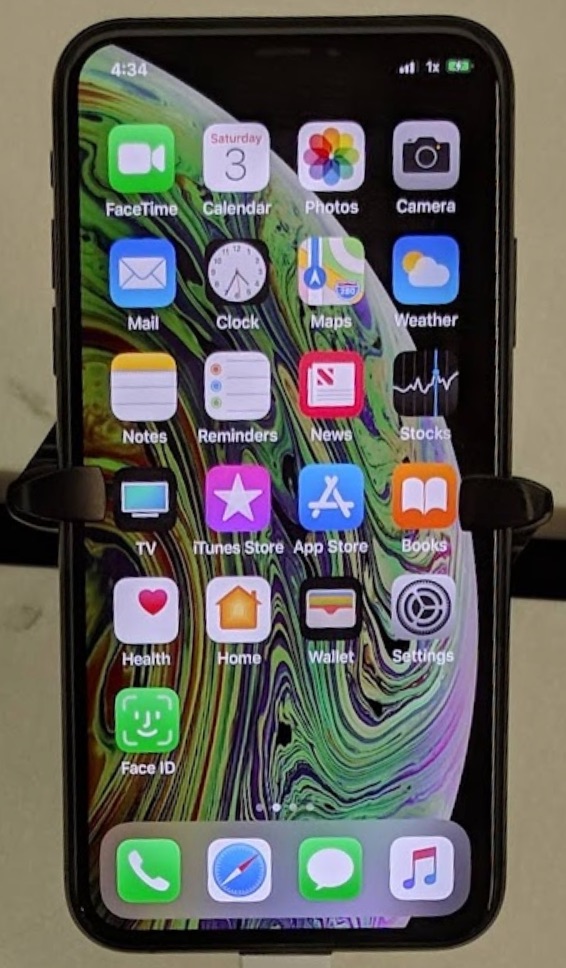
Since digital became an option, it’s slowly evolved to become the default option. The Bullet Journal philosophy questions whether this is necessarily a good thing. It’s not simply a luddite disdain for “new”, longing for a return to some imagined “glory days of the past”… it’s an argument about what genuinely works better - and is better for you.
Physical
Clarity
Bullet Journals benefit from Desired Difficulty. Space on a page is limited. Physically writing things takes time. This forces you to slow down and consider what matters to you. You must Distill the vital few into your system, disregarding the trivial many. This approach eschews “getting it all done” and embraces “getting done that which matters”. It’s one of my core philosophies that this the better way to live.
Freeform
Pen on paper is also a very liberating way to externalize the mind. You aren’t stuck working in the serialized world of typed text. Row ten, column six. My notebooks are filled with stars, doodles, circles and all forms of arrows & flowcharts. Text all askew. Some level of messiness is a feature, not a bug.
Durability
There are books in the world today that are thousands of years old. Meanwhile, Microsoft Word document I wrote less than a decade ago look all weird now when you open them in Word today… and anything I wrote in erstwhile apps like “springpad”, is now just fully gone. Anything captured to paper will remain in that state forever - there’s no concern of file formats becoming outdated. They aren’t threatened by “the cloud” going down or hard drives dying.
Digital
All that said, there are also good, compelling reasons to prefer digital.
Search & Filter
There’s no way to gather statistics about a bullet journal without reading it and creating them yourselves. The ability to ctrl + f is so ubiquitous now it’s easy to forget that you used to have to scour books, consult indexes and tables of contents looking for (whatever). If you’re consulting a series of bullet journals, trying to remember the time where you wrote down the thing about your car… ho boy.
Pivoting
This gets into pretty data-specific territories - but in physical forms you have to commit to presentation of data up front. There’s no easy way to “pivot” from bucketing things by week, versus bucketing things by type. The ability to separate view from an underlying data model is a super power of digital.
Backup
This is sort of the antithesis of the “durability” angle - but if a physical notebook containing all your notes is in the same bag as your shampoo that explodes… you’ve got a problem. The ability to create backups of your journal frees you from fear of a careless placed glass of water ruining the central feature of your organized life.
Best of Both Worlds
I believe both physical and digital mediums have a place in our lives. Your preferences obviously may shift your balance between “mostly digital” or “mostly physical”, but the choice need not be binary3. There are a few approaches you could take here, but I’ll focus on two of them.
The Medium Method
A term originally coined in this article by Chad Hall, the Medium Method essentially boils down to using both digital tools and physical tools, with pre-planned hand-offs between the two. The specifics of the method aren’t important (in my eyes, at least) but the idea is to use the approach (physical/digital) that suits the situation, then move the relevant bits to the other at a later time in accordance with your chosen plan.
So you could: Capture everything physically throughout the day, then transcribe to digital each night as part of a Nightly Review.
…or: Use digital tools throughout the day, the distill that which deserves it and migrate to your physical notebook as part of a pre-bedtime ritual.
Obsidian as a Digital Bullet Journal
Here’s where this Column got so hyper-specific I decided to move this content to its own dedicated page.
The TL;DR is what I’m trying right now. Basically a Medium Method where the physical part is pretty minimalist (on the order of a daily post-it note) and the digital aspect utilizes Obsidian and durable file types.
Top 5: Bullet Journal Module Types
What separates a bullet journal from, say, a journal you may have kept when you were younger is the systematic use of modules. These modules have different uses, but dovetail into one another to make the system coherent & cohesive. Included here are all the “main” modules extensively covered in the book, but other types are possible.
Note
These are very utilitarian examples - most of the other examples you’ll find online are much more pretty to look at. I’ll include links to prettier examples.
5. Index
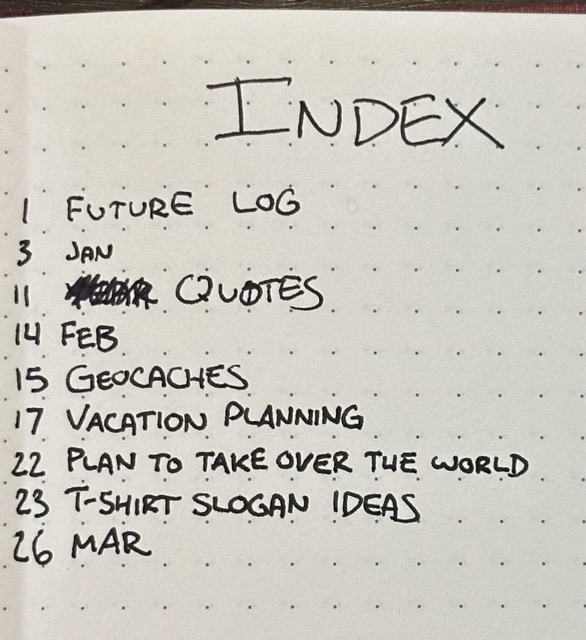 The index is usually the first few pages. It’s page numbers for Collections, Monthly Logs, and Future Logs. Daily pages don’t get indexed.
The index is usually the first few pages. It’s page numbers for Collections, Monthly Logs, and Future Logs. Daily pages don’t get indexed.
More info & prettier examples of indexes.
4. Future Logs
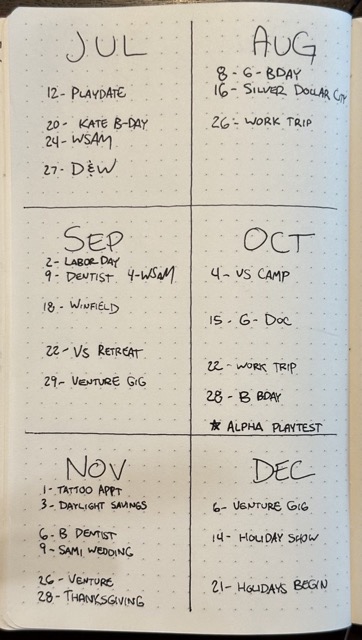 A future log is typically a whole-year overview. A spread containing boxes for every month, in each month are big events and goals you have for the month.
A future log is typically a whole-year overview. A spread containing boxes for every month, in each month are big events and goals you have for the month.
Prettier examples of future logs.
3. Monthly Logs
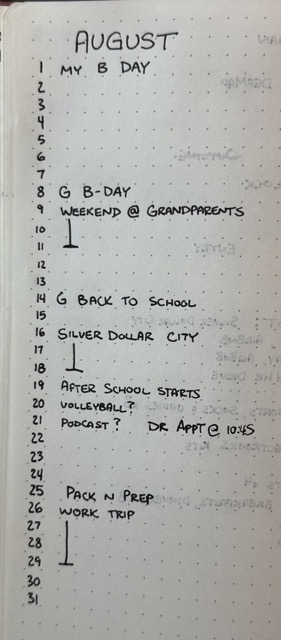 A monthly log is a list of the days of the month you’re in and whatever important things need to happen on that day. Things like a party you’re hosting, a doctor’s appointment, important deadlines - or other such things that fall out of the standard daily/weekly routine.
A monthly log is a list of the days of the month you’re in and whatever important things need to happen on that day. Things like a party you’re hosting, a doctor’s appointment, important deadlines - or other such things that fall out of the standard daily/weekly routine.
Prettier examples of monthly logs.
2. Daily Logs/ Rapid Logging
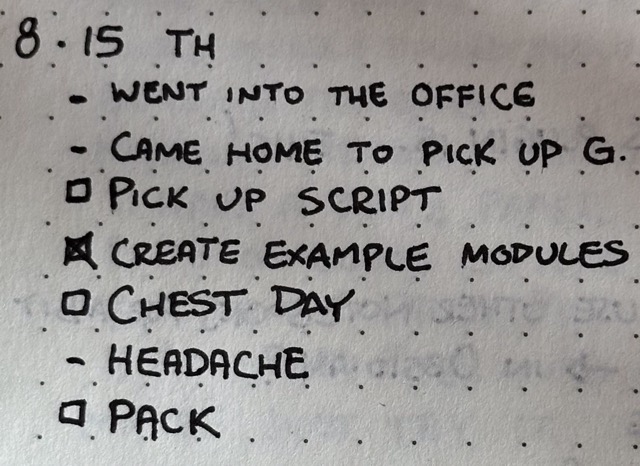 These take up the bulk of a “standard” Bullet Journal. They are a heading for a new day, and any little events, notes, observations, or tasks you pickup throughout the day. They are meant to be very economical in terms of letters written and info captured.
These take up the bulk of a “standard” Bullet Journal. They are a heading for a new day, and any little events, notes, observations, or tasks you pickup throughout the day. They are meant to be very economical in terms of letters written and info captured.
Standard note taking bullet
- I sent an email to Samantha asking for next Friday off for the trip.
- I should remember to pack the night before so I can wake up and go.
Rapid log
- emailed boss re: time off
- ⭐️ Pack night before
1. Collections
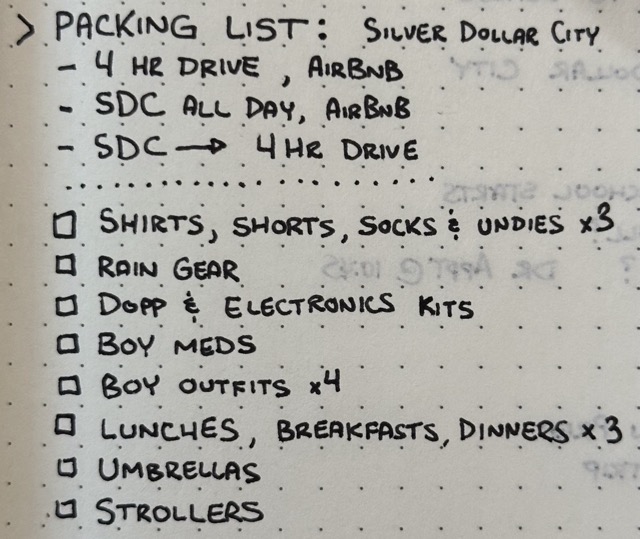 “Collections” are Ryder Carrol’s catch-all term for “anything else”, adhering to a theme. Common collections include:
“Collections” are Ryder Carrol’s catch-all term for “anything else”, adhering to a theme. Common collections include:
- Trackers - habits, diet, workouts, books read, movies, etc
- Quotes you like
- Reference info about (whatever)
- Plans about an upcoming vacation
- Joke ideas
The idea is it that it’s a spot designated for a type of thing that you might come back to or add to over time. Another name for “Collections” could have been “References and repositories”.
More info & prettier examples.
Quote:
I can’t move my bones outside my body, see? - My 6 year old, demonstrating his inability to remove his bones to his 3 year old brother
